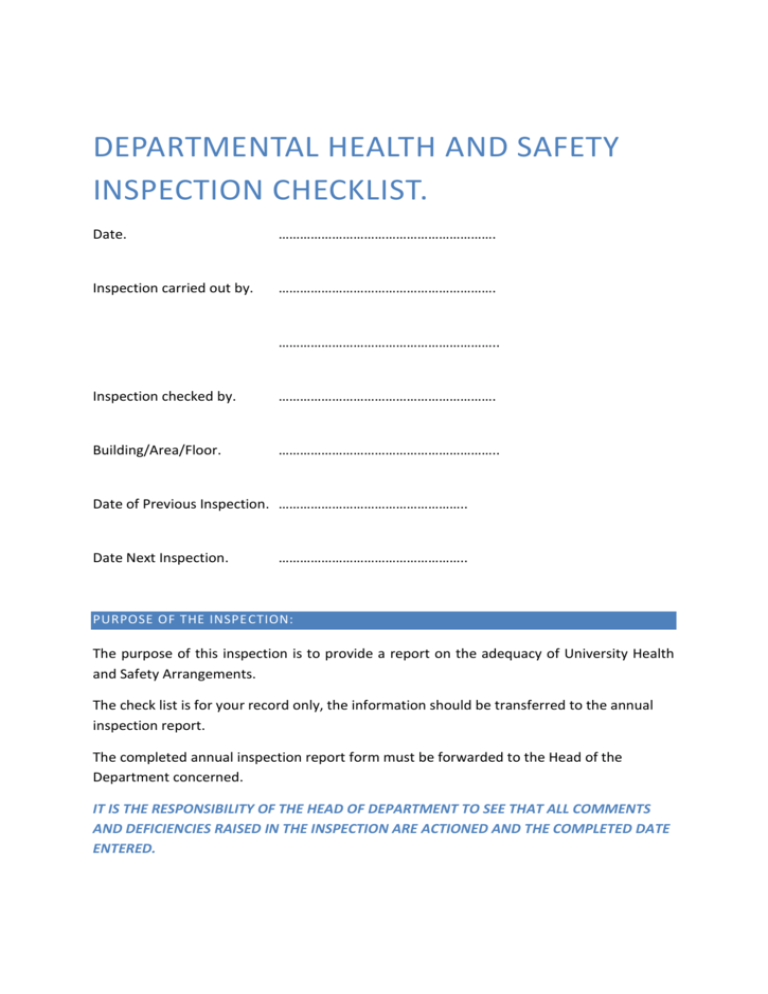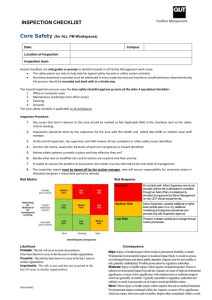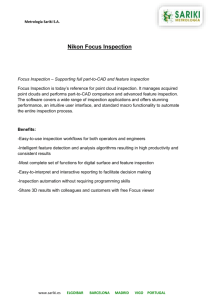Departmental Health And Safety Inspection Checklist
advertisement

DEPARTMENTAL HEALTH AND SAFETY INSPECTION CHECKLIST. Date. ……………………………………………………. Inspection carried out by. ……………………………………………………. …………………………………………………….. Inspection checked by. ……………………………………………………. Building/Area/Floor. …………………………………………………….. Date of Previous Inspection. …………………………………………….. Date Next Inspection. …………………………………………….. PURPOSE OF THE INSPECTION: The purpose of this inspection is to provide a report on the adequacy of University Health and Safety Arrangements. The check list is for your record only, the information should be transferred to the annual inspection report. The completed annual inspection report form must be forwarded to the Head of the Department concerned. IT IS THE RESPONSIBILITY OF THE HEAD OF DEPARTMENT TO SEE THAT ALL COMMENTS AND DEFICIENCIES RAISED IN THE INSPECTION ARE ACTIONED AND THE COMPLETED DATE ENTERED. CHECKLIST OF ITEMS TO BE INSPECTED 1. WORKING ENVIRONMENT a) Is it too hot? No Yes n/a b) Is it too cold? No Yes n/a c) Is there adequate ventilation? Yes No n/a d) Is the lighting level adequate? Yes No n/a e) Is the environment dusty? No Yes n/a f) Health and Safety notice displayed? Yes No n/a g) Is the work environment noisy? No Yes n/a a) Inspection area tidy, clean and well organised? Yes No n/a b) Access ways obstructed? No Yes n/a c) No Yes n/a Yes No n/a COMMENTS: WORKING ENVIRONMENT Action required Person responsible Date completed 2. HOUSEKEEPING Tripping hazards (including floor finishes)? d) All electrical cleaning equipment tested? e) All equipment stored under correct conditions? Yes No n/a f) Rubbish disposal area clean and clear? Yes No n/a g) Sharps removal procedure in place? Yes No n/a Yes No n/a a) Correctly stored? Yes No n/a b) Shelving overloaded/stacked incorrectly? No Yes n/a c) Yes No n/a Yes No n/a h) No smoking signs in position? COMMENTS: HOUSEKEEPING Action required Person responsible Date completed 3. MATERIAL STORAGE Shelving in good condition? d) Suitable access to high level storage? COMMENTS: MATERIAL STORAGE Action required Person responsible Date completed 4. ELECTRICAL a) Is all portable equipment tested and labeled? Yes No n/a b) Leads undamaged? Yes No n/a c) Trailing leads? No Yes n/a d) Sockets overloaded? No Yes n/a a) Procedure for inspection/records? Yes No n/a b) Equipment in good condition? Yes No n/a c) Company I.D./marking? Yes No n/a d) Procedure for erection? Yes No n/a COMMENTS ELECTRICAL Action required Person responsible Date completed 5. LADDERS/STEP LADDERS COMMENTS: LADDERS/STEPLADDERS Action required Person responsible Date completed 6. KITCHEN AREAS a) Safety notices in place? Yes No n/a b) Cleaning schedule in place? Yes No n/a c) Microwave sticker in place? Yes No n/a d) Spillage procedure in place? Yes No n/a a) Toilet area clean and tidy? Yes No n/a b) Adequate soap? Yes No n/a c) Yes No n/a Yes No n/a COMMENTS: KITCHEN AREAS Action required Person responsible Date completed 7. TOILET FACILITIES Hand towels/drying facilities in place and working? d) Adequate toilet paper? e) Sanitary disposal in place? Yes No n/a f) Sanitary vending in place? Yes No n/a g) Walls and surfaces clean? Yes No n/a a) Name of appointed person displayed and dated? Yes No n/a b) Telephone number for appointed person displayed? Yes No n/a c) Yes No n/a Yes No n/a COMMENTS: TOILET FACILITIES Action required Person responsible Date completed 8. FIRST AID Emergency telephone number displayed? d) Accident reporting procedure in place? COMMENTS: FIRST AID Action required Person responsible Date completed 9.FIRE PRECAUTIONS a) Routes clear of obstructions? Yes No n/a b) Fire doors easily opened? Yes No n/a c) Fire doors propped open? No Yes n/a d) Emergency lighting adequate? Yes No n/a e) Evacuation routes clearly signed? Yes No n/a f) Extinguishers in place? Yes No n/a g) Extinguishers in date? Yes No n/a h) Correct type? Yes No n/a i) Identification label in place? Yes No n/a j) Hose reels in test? Yes No n/a k) Smoke/heat detectors checked? Yes No n/a Yes No n/a COMMENTS: FIRE PRECAUTIONS Action required Person responsible Date completed 10. FIRE INSTRUCTIONS a) Posted up? b) Defaced or damaged? No Yes n/a c) Yes No n/a d) Weekly test undertaken? Yes No n/a e) Annual evacuation undertaken? Yes No n/a f) Evacuation chairs in place? Yes No n/a g) Fire risk assessment completed? Yes No n/a Current and up to date? COMMENTS: FIRE INSTRUCTIONS Action required Person responsible Date completed 11. COSHH (CONTROL OF SUBSTANCES HAZARDOUS TO HEALTH). a) COSHH assessments OK? Yes No n/a b) Exposure adequately controlled? Yes No n/a c) Yes No n/a d) Spillage procedure in place? Yes No n/a e) Correctly stored? Yes No n/a f) Correctly disposed of? Yes No n/a g) Disposal of hazardous waste in place? Yes No n/a Data sheet information available? Yes No n/a a) All guards in place? Yes No n/a b) Kept clean of rubbish? Yes No n/a c) Emergency stop buttons fitted? Yes No n/a d) Safety warning notices in place? Yes No n/a e) Risk assessment in place? Yes No n/a h) Flammable liquids correctly stored/signed? COMMENTS: COSHH Action required Person responsible Date completed 12. MACHINERY COMMENTS: MACHINERY Action required Person responsible Date completed 13. PPE (PERSONAL PROTECTIVE EQUIPMENT). a) Correct type for hazard identified? Yes No n/a b) Good condition? Yes No n/a c) Yes No n/a a) Full? Yes No n/a b) In date? Yes No n/a c) Yes No n/a Yes No n/a Correctly stored? COMMENTS: PPE Action required Person responsible Date completed 14. EYEWASH BOTTLES/CYLINDERS Correctly stored/fixed? d) Correct pressure? COMMENTS: EYEWASH BOTTLES/CYLINDERS Action required Person responsible Date completed 15. OUTSIDE AREAS a) Roadways in good condition? Yes No n/a b) Pavements in good condition? Yes No n/a c) Yes No n/a d) Steps clear of obstructions and clean? Yes No n/a e) Cycle racks being used? Yes No n/a f) Hand rails in good condition? Yes No n/a g) All lights working? Yes No n/a Yes No n/a Access ramps in place? h) All notices in place? COMMENTS: OUTSIDE AREAS Action required Person responsible Date completed GUIDANCE NOTES 1. 2. 3. a/b The minimum working temperature must be 16°C. There is no upper limit. c Is there a ventilation system? Is it working? Can windows be opened? d Is there enough light to see by? e Is there excessive dust in the area and where is it coming from? f Is there a health and safety law poster displayed and are all the contact names and telephone numbers correct and up to date? g You should be able to hold a normal conversation with another person who is standing about 1 meter away from you. If you have to shout it is too noisy. a Is the housekeeping in the inspection area in good order? b All access ways must be unobstructed. No items must be left in the access ways. c Anything that could cause a tripping hazard must be identified, such as worn carpet, loose carpet tiles, loose or missing stairs treads etc. d All electrical cleaning apparatus must have a current in test sticker on it. If no test identification, the equipment must not be used until tested. e All equipment must be stored in the correct places and not just left lying about in the area. f Is the area where rubbish is stored clean and tidy, with no rubbish left lying about? g Is there a container in the area where sharps can be placed and do people know what to do when the container needs to be emptied? h Are ‘no smoking’ signs displayed at the entrance to the building? a Is all material stored correctly, i.e. heavy items at the bottom, lighter items located higher up? No glass items must be stored above head height. 4. 5. 6. 7. b The storage shelving must not be overloaded. All items must be stored in an orderly fashion and not just dumped on the shelving. c Shelving must be in good condition with no broken shelves or makeshift shelves. d If ladders are required to reach items they must be in good condition and tested. a All portable electrical equipment must have a current in date test sticker on the appliance. If no sticker or test out of date equipment must not be used until retested. (all new electrical equipment purchased has a 12 month PAT in place). b Are any extension leads or leads to any appliance in good order, free from cuts or damage? No taped joints. c Make sure there are no trailing leads that could cause a trip hazard in the work place. If used they must be in a protected cover. d Make sure that there is the correct amount of plugs in a socket and it is not overloaded by the use of an adaptor. 1 plug per socket. a Is there a formal procedure for ladder inspection and is it documented? b In your opinion, are the ladders in good condition? c Is there a name on the ladders or ID marking? d Is there a written procedure or instructions for how to erect the ladders? a Are all safety notices displayed in the kitchen area? b Is there a cleaning schedule in place and is it being adhered to? c Is there a microwave sticker in place? d are all spillages cleaned as they happen a Is the inspected toilet area clean and tidy? b Is there an adequate amount of soap in the toilets? c Are there hand towels in place? If there are hand dryers, are they in a good working condition? Check flexes do they blow warm air. 8. 9. d Is there enough toilet paper in the cubicles? e Is there a method in place for disposal of sanitary items? f Is there a sanitary vending machine in place and is it in good working order? g Are all the walls and surfaces clean? a Is there a notice displayed with the appointed first aid person for the area and does it have a date included to ensure that it has been up dated regularly? b Is there a telephone number or contact details for that person? c Is the emergency telephone number displayed normally 999? d Is the correct procedure being used for reporting accidents university accident form? a All fire evacuation/emergency routes must be kept clear and be unobstructed. b Fire doors must be able to open easily and must not be obstructed in any way. c Fire doors must not be propped open, as when they are closed they will prevent the spread of fire within the building. d Is emergency lighting fitted in the area near to emergency exits and does it work records of inspection should be held in reception? e Are there emergency exit signs directing staff to the nearest exit? f Are all fire extinguishers in place? There must be none missing. g There will be a sticker on the extinguisher with the date it was last tested. This must not exceed 12 months. If over 12 months it needs re-testing. h Is the extinguisher the correct type for the area that it is in? i Is there an extinguisher identification label near to the extinguisher informing you what type the extinguisher is and on what class of fire it can be used on? j Have all hose reels been tested and do they have an in date sticker in place? k Have smoke and heat detectors been checked for correct working records should be held in the reception? 10. a Are fire evacuation instructions posted in the inspection area? b They must be clear and legible. c The instructions must be up to date. d Is there a documented weekly fire alarm test undertaken? Is there evidence of this records held in reception? e check the fire record book for the evacuation date normally 1st term f If there is an evac chair in the area is it in place, is it signed, in good condition and is the area around the chair clear of all obstructions? g Has there been a fire risk assessment undertaken for the building (normally kept at reception)? 11. a Has there been a COSHH assessment undertaken for the chemical in use? If not, one must be done. b Is the exposure to the chemical adhered to as recommended on the data sheet? c Is the data sheet available? This sheet contains valuable information for medical treatment if the chemical is swallowed etc. d/e Is there a spillage procedure in place, i.e. what to do if there is a spill, how to clean the spill and how to dispose of the spill material? f/g Is hazardous waste disposed of in the correct way, i.e. chemicals, sharps, fluorescent lighting tubes, batteries, etc, must not be disposed of in a skip? h All flammable liquids and materials must be stored in flammable areas and have the correct signage displayed. 12. a All guards that protect people from moving parts are in place and in good condition. b The area around the machine is kept free from any rubbish that could hinder the correct use of the machine or contribute to an accident. c Make sure that there is an emergency stop button fitted to the machine and if it is safe to do so test the button to see if it works correctly. d Are there warning and safety notices in place? e 13. a Has a risk assessment been undertaken for the machinery in question? Is the correct type of PPE being used in the area that has been identified this could be from a risk assessment? b Is the PPE in good condition? If not it must be replaced. c When the PPE is not being used is it being stored in the correct way (not just left lying about the work area)? 14. a Eye wash bottles must be full and the seal must not be broken. Once the seal has been broken, the contents must be disposed of. b Eye wash bottles have a use by date stamped on the outside of the container. The contents must not be used after that date. c Eye wash containers must be stored in the correct way i.e. fixed to the wall or kept on correct holder etc. d If a cylinder type of eye wash is used the pressure on the dial must be at the correct pressure. 15. a Are the roadways within the university’s premises in good condition or are they in need of repairs, i.e. pot holes, water puddles, raised sections etc.? b Are the pavements within the university’s premises in good condition and free from holes, uneven flags, loose flags, etc.? c If there are ramps to allow disabled people access into buildings, are they in place and in good condition? d Are all steps free from obstructions that could cause an accident, i.e. slip, trip, fall? e Are cycle racks in place and are they being used cycles not stored or locked to railings etc? f Are all hand rails in good order, with no loose or broken parts? g Are all outside lights in good working order? (This may have to be assessed at night.) h Are all notices in place informing people of the university’s procedures? MANCHESTER METROPOLITAN UNIVERSITY FACULTY/DIVISIONAL/SERVICE INSPECTIONS ANNUAL REPORT DEPARTMENT INSPECTION TEAM INSPECTION DATES Please list overleaf any significant issues or items outstanding from the Inspections. The following checklist may be useful: Communications (means of raising issues, availability of policy, accident forms) First Aid provision Fire safety Electrical safety Lighting, heating and ventilation Display screen equipment Cleaning Access (eg trailing cables, storage, loose fixtures and fittings) HEAD OF DIVISION/FACULTY/SERVICE/HEALTH AND SAFETY REPRESENTATIVE COMMENTARY SIGNATURE _____________________________________________ HEAD OF DIVISION/FACULTY/SERVICE Please note: Immediate preventative action must be taken where significant hazards are identified which pose a serious risk of harm to staff, students and visitors. Inspections should comply with the University’s Guidance Notes on Departmental Inspections. A detailed record of inspections and actions identified must be retained in the Department. KEY ISSUES RAISED DURING THE INSPECTION: IN PRIORITY ORDER SUBJECT REASON ACTION TAKEN BY HoD / DEPARTMENT REFERRED TO: STATUS

